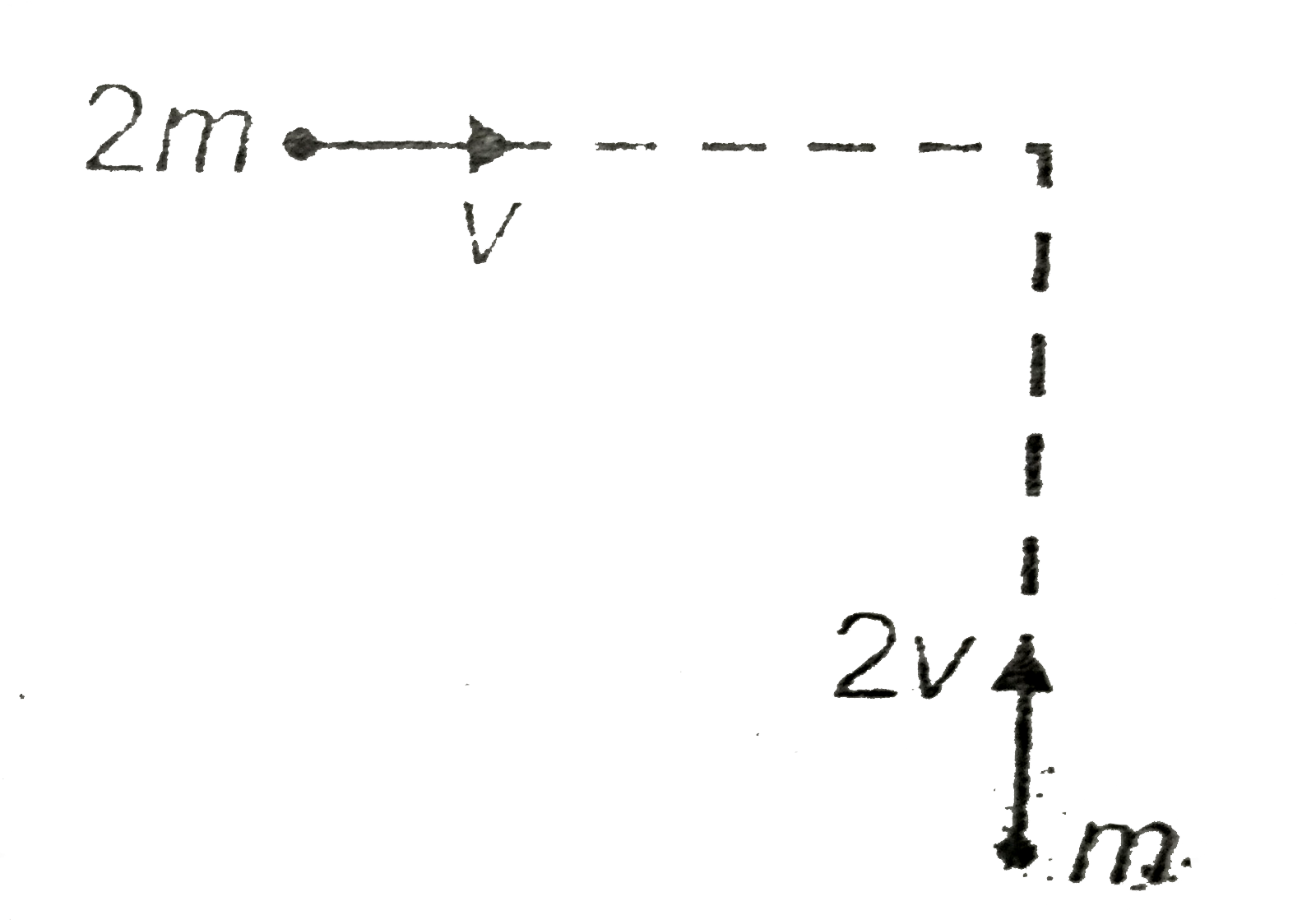Two balls of masses 2m and m are moving with speed 2v0 and v0 towards each other. If the coefficient of restitution e=1/3 , the speed of balls , if collision is head - on
v03,4v03
2v03,5v03
2v03,4v03
v03,2v03
The correct Answer is:B
To solve the problem step by step, we will use the principles of conservation of momentum and the coefficient of restitution.
Step 1: Define the masses and velocities
Let:
- Mass of ball 1, m1=2m with initial velocity u1=2v0 (moving to the right)
- Mass of ball 2, m2=m with initial velocity u2=−v0 (moving to the left)
Step 2: Write the conservation of momentum equation
Since the collision is head-on and there are no external forces acting on the system, the momentum before the collision is equal to the momentum after the collision.
Initial momentum:
pinitial=m1u1+m2u2=(2m)(2v0)+(m)(−v0)=4mv0−mv0=3mv0
Let v1 be the final velocity of ball 1 and v2 be the final velocity of ball 2. The final momentum is:
pfinal=m1v1+m2v2=(2m)v1+(m)v2
Setting initial momentum equal to final momentum:
3mv0=2mv1+mv2
Dividing through by m:
3v0=2v1+v2(Equation 1)
Step 3: Use the coefficient of restitution
The coefficient of restitution e is given as 13. The formula for the coefficient of restitution is:
e=v2−v1u1−u2
Substituting the values:
13=v2−v1(2v0)−(−v0)=v2−v13v0
Cross-multiplying gives:
v2−v1=13⋅3v0=v0(Equation 2)
Step 4: Solve the equations simultaneously
Now we have two equations:
1. 3v0=2v1+v2 (Equation 1)
2. v2−v1=v0 (Equation 2)
From Equation 2, we can express v2:
v2=v1+v0
Substituting this expression for v2 into Equation 1:
3v0=2v1+(v1+v0)
3v0=3v1+v0
3v0−v0=3v1
2v0=3v1
v1=2v03
Step 5: Find v2
Now substitute v1 back into Equation 2 to find v2:
v2=v1+v0=2v03+v0=2v03+3v03=5v03
Final Answer
The final velocities after the collision are:
- v1=2v03 (for mass 2m)
- v2=5v03 (for mass m)
Let:
- Mass of ball 1, m1=2m with initial velocity u1=2v0 (moving to the right)
- Mass of ball 2, m2=m with initial velocity u2=−v0 (moving to the left)
Since the collision is head-on and there are no external forces acting on the system, the momentum before the collision is equal to the momentum after the collision.
pinitial=m1u1+m2u2=(2m)(2v0)+(m)(−v0)=4mv0−mv0=3mv0
pfinal=m1v1+m2v2=(2m)v1+(m)v2
3mv0=2mv1+mv2
3v0=2v1+v2(Equation 1)
The coefficient of restitution e is given as 13. The formula for the coefficient of restitution is:
e=v2−v1u1−u2
13=v2−v1(2v0)−(−v0)=v2−v13v0
v2−v1=13⋅3v0=v0(Equation 2)
Now we have two equations:
1. 3v0=2v1+v2 (Equation 1)
2. v2−v1=v0 (Equation 2)
v2=v1+v0
3v0=2v1+(v1+v0)
3v0=3v1+v0
3v0−v0=3v1
2v0=3v1
v1=2v03
Now substitute v1 back into Equation 2 to find v2:
v2=v1+v0=2v03+v0=2v03+3v03=5v03
The final velocities after the collision are:
- v1=2v03 (for mass 2m)
- v2=5v03 (for mass m)
Topper's Solved these Questions
Similar Questions
Two balls of equal mass have a head-on collision with speed 6m/s. If the coefficient of restitution is 13, find the speed of each ball after impact in m/s
View SolutionA collision occurs between two identical balls each of mass m, moving with velocities →u1 and →u2, colliding head-on. The coefficient of restitution is 0.5. The energy lost in the collision is:
View Solution
Knowledge Check
A ball of mass m moving with a speed 2v0 collides head-on with an identical ball at rest. If e is the coefficient of restitution, then what will be the ratio of velocity of two balls after collision?
A1−e1+eB1+e1−eCe−1e+1De+1e−1A ball of mass m moving with velocity v collides head-on which the second ball of mass m at rest. I the coefficient of restitution is e and velocity of first ball after collision is v1 and velocity of second ball after collision is v2 then
Av1=(1−e)u2,v2=(1+e)u2Bv1=(1+e)u2,v2=(1−e)u2Cv1=u2,v2=−u2Dv1=(1+e)u,v2=(1−e)uA block of mass m moving with speed v0 strikes another particle of mass 2m at rest. If collision is head - on and the coefficient of restitution e=1/2 , then the loss in kinetic energy will be
A12mv20B13mv20C23mv20D34mv20
A ball of mass m hits the floor with a speed v0 making an angle of incidence α with the normal. The coefficient of restitution is e. find the speed of the reflected ball and the angle of reflection of the ball.
View SolutionTwo particles of mass 2m and m moving with speed v and 2v respectively pependicular to each other collides perfectly inelastically, then

Speed of the particles after collision
View SolutionA ball of mass m hits a floor with a speed v0 making an angle of incidence α with the normal. The coefficient of restitution is e. Find the speed of the reflected ball and the angle of reflection of the ball.
View SolutionA ball of mass m hits another identical ball head on with speed 3u. Speed of the other ball was u in same direction Coefficient of restitution e=0. Percentage of KE lost in collision is 5x. Write x
View SolutionA ball of mass m hits another identical ball head on with speed 3u .Speed of the other ball was u in same direction Coefficient of restitution e=0 Percentage of KE lost in collision is 5x .Write x .
View Solution

